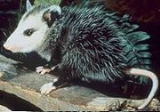
Common Opossum
Encyclopedia
The common opossum also called the southern or black-eared opossum, is a mammal
species living from the northeast of Mexico
to Bolivia
, including the Lesser Antilles
, where it is called manicou. It prefers the woods, but can also live in fields and cities. The common opossum is sometimes used for food in poorer areas by humans.
, at altitudes up to 2200 m. They use a wide range of nest sites. Most commonly they will create one in the hollow of a tree; however, they will also dig a burrow or nest in any dark location if nothing else is suitable (which often gets them in trouble with humans).
Mammal
Mammals are members of a class of air-breathing vertebrate animals characterised by the possession of endothermy, hair, three middle ear bones, and mammary glands functional in mothers with young...
species living from the northeast of Mexico
Mexico
The United Mexican States , commonly known as Mexico , is a federal constitutional republic in North America. It is bordered on the north by the United States; on the south and west by the Pacific Ocean; on the southeast by Guatemala, Belize, and the Caribbean Sea; and on the east by the Gulf of...
to Bolivia
Bolivia
Bolivia officially known as Plurinational State of Bolivia , is a landlocked country in central South America. It is the poorest country in South America...
, including the Lesser Antilles
Lesser Antilles
The Lesser Antilles are a long, partly volcanic island arc in the Western Hemisphere. Most of its islands form the eastern boundary of the Caribbean Sea with the Atlantic Ocean, with the remainder located in the southern Caribbean just north of South America...
, where it is called manicou. It prefers the woods, but can also live in fields and cities. The common opossum is sometimes used for food in poorer areas by humans.
Habitat and shelter
This opossum is found in tropical and subtropical forest, both primary and secondarySecondary forest
A secondary forest is a forest or woodland area which has re-grown after a major disturbance such as fire, insect infestation, timber harvest or windthrow, until a long enough period has passed so that the effects of the disturbance are no longer evident...
, at altitudes up to 2200 m. They use a wide range of nest sites. Most commonly they will create one in the hollow of a tree; however, they will also dig a burrow or nest in any dark location if nothing else is suitable (which often gets them in trouble with humans).

